Build-A-Rig Round 1, Zotac vs. Corsair: The $1500 PC Showdown
by Ryan Smith on August 5, 2015 6:00 AM EST- Posted in
- Build-A-Rig
- Systems
- Corsair
- ZOTAC
Gaming Performance
Shifting gears to gaming performance, and the focus of our $1500 Build-A-Rig challenge builds, the GPU becomes a much greater factor here, as these tests will shift between being CPU limited at lower resolutions and outright GPU limited at higher resolutions. As a reminder, Zotac went with one of their factory overclocked GeForce GTX 970 cards, while Corsair went with a Zotac reference GeForce GTX 980 Ti. Meanwhile the theoretical GPU performance difference between the two systems is greater than their CPU differences, however resolution will be an important factor here. Ultimately the Corsair system was designed to focus on 1440p and 4K gaming while the Zotac was not, so we’ve structured our testing accordingly.
We’ll start off our look at gaming performance then with our synthetic 3DMark gaming benchmarks. When working across vendors these benchmarks can be a little more problematic, but since both systems are using GeForce GTX 900 series cards, we should get some reliable results for how the gaming performance of the two systems differs.

The latest version of 3DMark puts the Corsair system solidly in the lead. The actual lead depends on the sub-test used, but on the more aggressive tests the Corsair system enjoys a 30-35% lead over the Zotac system.

The story is much the same with the older 3DMark 11. Once we crank up the test settings to something more befitting of these high-end GPUs, the Corsair system holds a lead of around 34%. However it’s interesting to note that the significant factory overclock on the Zotac GTX 970 and its ability to better avert thermal throttling means that these cards are closer than a cursory look at specifications might suggest.
Moving on to our real world gaming benchmarks, we’ll start with The Talos Principle. Croteam’s first person puzzle and exploration game The Talos Principle may not involve much action, but the game’s lush environments still put even fast video cards to good use. Coupled with the use of 4x MSAA at Ultra quality, and even a tranquil puzzle game like Talos can make a good case for more powerful video cards.
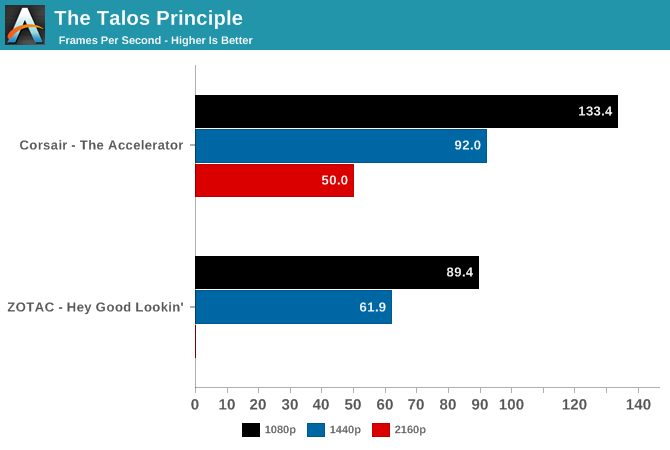
On our first real world game benchmark the Corsair system starts out especially strong here. The performance advantage for Corsair’s system is nearly 50% at both 1080p and 1440p, something of a best case scenario for both cards. In either case, the Zotac system can easily average 60fps at 1440p, hitting Zotac’s goals, while the Corsair system can’t quite hit 60fps at 4K, but still delivers more than playable performance for the rigors of such a high resolution.
Moving on, Total War: Attila is the latest game in the Total War franchise. Total War games have traditionally been a mix of CPU and GPU bottlenecks, so it takes a good system on both ends of the equation to do well here. In this case the game comes with a built-in benchmark that plays out over a large area with a fortress in the middle, making it a good GPU stress test.
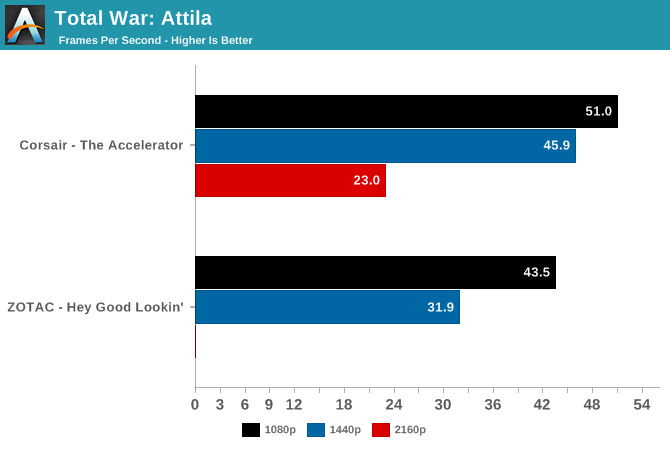
Attila is a great example of how one can be both CPU and GPU limited, especially when shifting resolutions. At 1080p the Corsair system is still in the lead, but not by much – we’re being held back by the CPU at times in this benchmark at this resolution. However shift to 1440p and the difference between the two systems opens up as it becomes much more strongly GPU-limited. In any case we’re not going to cross 60fps at any time with these settings regardless of the GPU, but since this is a strategy game 30fps is a more reasonable target.
For the racing game in our benchmark suite we have Codemasters’ GRID Autosport. Codemasters continues to set the bar for graphical fidelity in racing games, delivering realistic looking environments with layed with additional graphical effects. Based on their in-house EGO engine, GRID Autosport includes a DirectCompute based advanced lighting system in its highest quality settings, which incurs a significant performance penalty on lower-end cards but does a good job of emulating more realistic lighting within the game world.
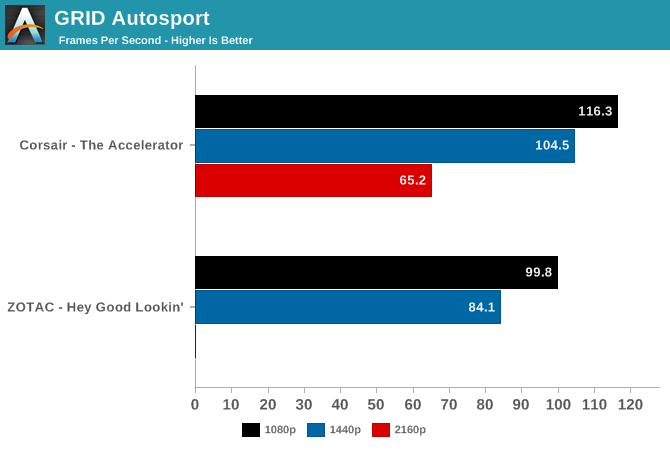
GRID is another game where we end up CPU limited at lower resolutions; it doesn’t manifest itself too strongly, but I suspect the difference in performance between the Corsair and Zotac systems at 1080p is more CPU driven than GPU driven. Which is why the performance difference between the two systems opens up a bit more at 1440p.
Up next we have Crysis 3. With Crysis 3, Crytek has gone back to trying to kill computers and still holds the “most punishing shooter” title in our benchmark suite.
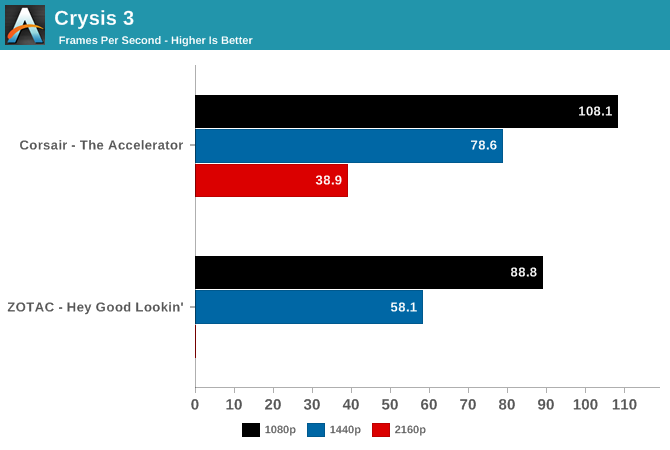
A more pure GPU benchmark in our test suite, Crysis 3 puts the Corsair system ahead by 35% at 1440p. However in the process the Zotac system fares rather well for itself; the average framerate of 58fps being just shy of 60fps, so overall the Zotac system is still hitting its marks. What it can’t do is run at 4K, not that the Corsair system does exceptionally well either due to the strain of pushing so many pixels.
The final game in our benchmark suite is Grand Theft Auto V. The latest edition of Rockstar’s venerable series of open world action games, Grand Theft Auto V was originally released to the last-gen consoles back in 2013. However thanks to a rather significant facelift for the current-gen consoles and PCs, along with the ability to greatly turn up rendering distances and add other features like MSAA and more realistic shadows, the end result is a game that is still among the most stressful of our benchmarks when all of its features are turned up.
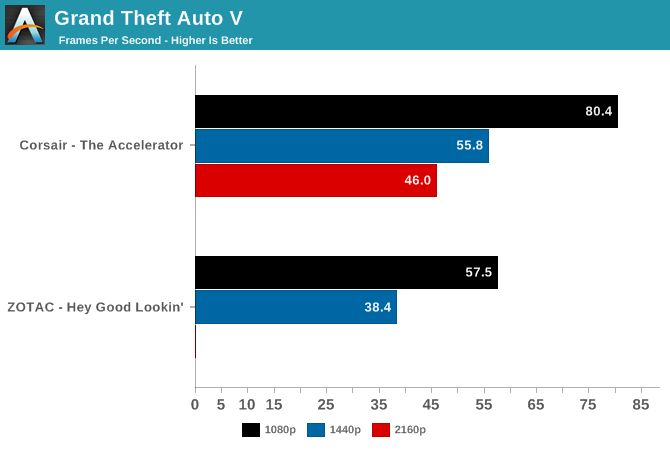
GTA V is another significant GPU stressor, resulting in the Corsair system taking a significant 40%+ lead here. Overall at these settings the Zotac system is going to be better off at 1080p, while the Corsair system can handle 1440p. Though even with its extra power, the Corsair system is struggling a bit with 4K, with a 46fps frame rate offering a bit less performance than what’s necessary for PC-standard smoothness.
Finally, while looking at gaming performance we’re also taking a look at GPU compute performance via CompuBench 1.5. Backed by OpenCL, we’ve picked out three of the benchmark’s suites best sub-tests, highlighting different use cases for GPU compute in modern systems.
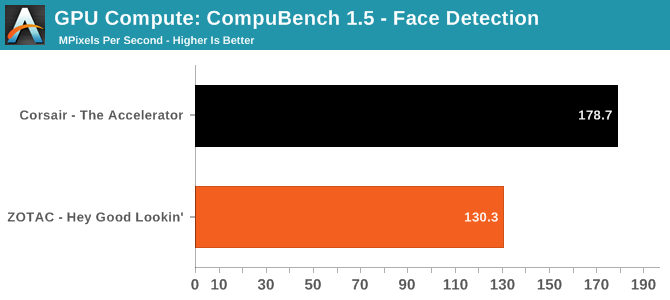
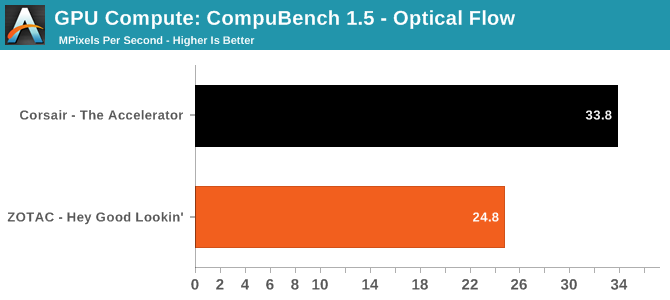
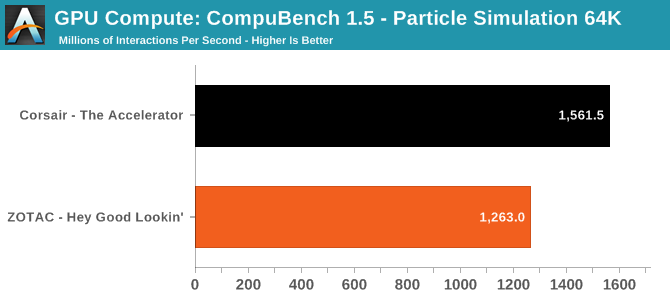
Overall the Corsair system retains a solid lead. How big of a lead varies with the sub-test, but it’s at least 20% across all of these sub-tests.










21 Comments
View All Comments
Refuge - Monday, August 10, 2015 - link
It is down to perspective in the end.I like LED strips if done properly. I also thought the Zotac build was very pretty.
Mikemk - Wednesday, August 5, 2015 - link
So will the winners be announced publicly?Ryan Smith - Wednesday, August 5, 2015 - link
That's a good question. Our corporate parent technically executes the contest, so I'll check with them on the matter.Drumsticks - Wednesday, August 5, 2015 - link
These are cool! I hope you do them well into the future, it's exciting to see what the companies come up with and some friendly competition is always fun to watch.I'd love to see Dustin/future people who add unlocked CPUs to their builds have them tested with an overclock added by y'all - after all, it's a huge benefit and the CPU performance advantage for Corsair here is kind of understated without it.
Either way, no surprises with the results. Both builds did what people really expected; nobody saw Zotac winning many performance runs, but then again, they weren't really trying to with their picks.
Gasaraki88 - Thursday, August 6, 2015 - link
I don't get what the point of this article is. You take a computer that has a slower processor and video card and compare it to one that has a faster processor and video card. OK, guess who's slower?Ian Cutress - Thursday, August 6, 2015 - link
It's part of our give-a-way contest project called Build-A-Rig. We give two companies a budget and ask them to spec down a rig. We then interview them about the industry and what they chose, and then we get the parts from our partner Newegg, build the systems, test them, and then give them away to our readers.Read the intro: http://www.anandtech.com/show/9403/
Read the interviews and specification breakdowns: http://www.anandtech.com/show/9417/
Read the build logs for each system: http://www.anandtech.com/show/9474/
And this performance analysis is the final piece of the puzzle.
doggface - Sunday, August 9, 2015 - link
When I first saw that h100i in the zotac build it didnt make sense. Using it to blow away the heat from the 970 is clever.zerockslol - Saturday, August 15, 2015 - link
Anyone else notice the inconsistency with prices in the 90 day average?I added up the 90 day averages and it reached $1512.72 you're welcome
zerockslol - Saturday, August 15, 2015 - link
that was for Zotacs btwLegionosh - Monday, August 17, 2015 - link
While the Zoltac may look a little better, I'd much prefer the Corsair build due purely to performance reasons. The power consumption difference is nowhere near enough to warrant the performance difference in my opinion (and everyone has their own opinion).Granted the SSD does offer some performance benefits, but the difference in GPU and CPU performance more than makes up the difference for me. :-)